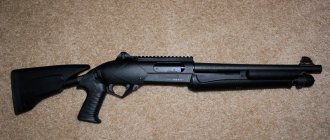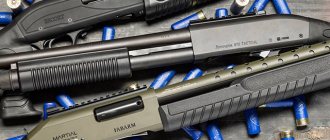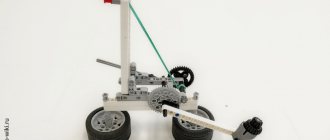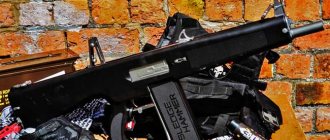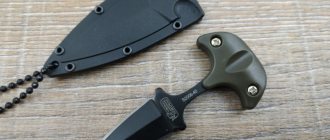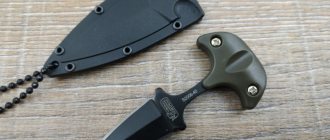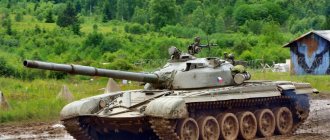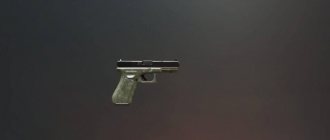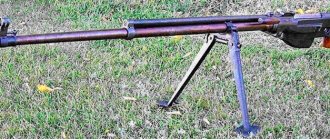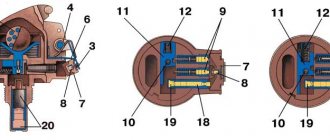Hunting smoothbore weapons are the most popular both in Russia and abroad. These guns are designed for shooting at short distances - up to 50 meters. They are used for different types of hunting: for feathered game in summer, for swamp game, on leks and from the approach, from under a gun dog and in corrals. The most popular gauge is 12. The ammunition used is shot, buckshot and bullets of various types. Shot charges are used most often. There are a large number of pellets on sale, which are classified by size: from number 10 to 0000. The diameter of the pellets increases by 0.25 mm from number to number. So the pellet number 10 has a diameter of 1.75, and the pellet number 0000 already has a diameter of 5 mm. When loading cartridges, the size of the shot is selected according to the intended object of hunting. Open and collimator sights are used as sighting devices.
The specificity of shooting from smooth-bore weapons does not favor the use of optical or night sights, since shooting is carried out at short distances with mutual visual contact with the target. The affected area of shot scree, as a rule, completely covers the body of the target, so precise aiming at the lethal zone, as is the case with rifled weapons, is not required here. In addition, shooting is carried out at moving targets and, often, the hunter simply does not have time to prepare and accurately aim.
Shotguns are shot at various distances in order to determine the optimal combat performance, as a rule, these are 20, 35 and 50 meters. The minimum distance is used when hunting swamp game, 35 meters for hunting waterfowl and the 50-meter mark is more suitable for hunting on migration in the autumn. During zeroing, it is necessary to select the optimal parameters for loading cartridges, which are associated with an increase or decrease in the accuracy of the battle, and an assessment of the lethality. Therefore, the classic zeroing of shotguns refers to a whole series of purely technical issues aimed at:
- Selecting a target for shooting;
- Determination of the degree of condensation of shot scree;
- Determination of shot uniformity;
- Determining the consistency of the battle:
- Assessing the possibility of killing game;
- Determining the sharpness of the weapon's combat;
- The influence of the magnitude of the muzzle constriction;
- And so on.
Let's look at each point in more detail.
Targets for shooting shotguns
The most common targets for zeroing shotguns are 16- and 100-length paper targets. They can be either with or without the image of an animal or bird. The main purpose is to assess the quality of the gun's combat and its main parameters, such as accuracy, uniformity of scree, the possibility of hitting game, etc. They do not have any fundamental differences and serve to perform completely similar tasks.
The 16-lobe target consists of two circles: inner and outer, which are divided into equal parts. The diameter of the outer circle is 750 mm, and the inner circle is 375 mm. The outer part of the target (outer ring) is divided into 12 equal parts. The area of each lobe is 276 cm2. This type of target is well suited for testing the accuracy of the gun, accuracy and degree of charge concentration. However, it is better to assess the uniformity of the scree using a 100-multiple target. Such targets are performed in various versions, for example, “Hare”, “Drake” and “Capercaillie”.
100-multiple targets allow you to more accurately assess the combat quality of shotguns. In size they are similar to 16 lobes. For example, targets A.A. The grains have an outer diameter of 750 mm, and there are also 6 concentric circles of smaller diameter, divided into an equal number of shares. Using this type of target, it will be possible to most accurately determine such parameters of a gun’s engagement as uniformity of scree and lethality. The most common 100-multiple target can be ordered here.
Separately, it is worth highlighting the frequently used wild boar target; it does not have divisions for calculation, but it displays all the main organs, a hit in which would be fatal for this type of animal. This prepares the hunter very well.
These targets are sold at affordable prices at any gun store, or you can make them yourself. To do this, you can download a layout of any target on the Internet and print it on regular A4 sheets and then connect it.
How to make fractions yourself
To make shot with your own hands, you will need to acquire a sufficient amount of lead, as well as a special “colander” in which the molten metal will take the form of drops. Here are more detailed instructions:
- We heat the lead in a cast iron or steel thicket until it becomes liquid.
- Pour the molten metal into a colander and close the lid properly.
- Place the tool in a barrel of cold water for 5 minutes.
After this, all that remains is to remove the pellets from the “colander” and clean them of excess burrs. Homemade ammunition is inferior in quality to store ammunition, but can also be used for fishing.
The shot can serve as a universal ballistic projectile for hunting. The most important thing is to choose the optimal diameter of the striking element and the best shooting distance.
Determining the degree of scree thickening
The degree of shot condensation is determined by the ratio of the number of pellets that hit the inner circle of the target to the number of pellets that hit the outer circle. The ratio of the areas of the outer circle on a 16-lobe target to the inner one is 3:1. Therefore, to correctly determine the degree of condensation, you should multiply the number of pellets hitting the inner circle by 3. A normal distribution is considered to be a ratio from 1:1 to 1:1.5.
Let's look at a small example. After shooting at a target from a distance of 35 meters, you counted 60 pellet holes in the inner circle, and 145 in the outer circle. To determine the ratio, we need to multiply 60 (the pellet that hit the inside of the target) by 3.
60 * 3 = 180
To determine the ratio, it is necessary to divide the assigned result by the number of holes in the outer circle (145).
180 / 145 = 1,24
As can be seen from the obtained result, the ratio is 1.24, which corresponds to the normal distribution of the shot over the entire target area.
If the result obtained exceeds the coefficient of 1.5 at a distance of 35 meters, it is generally accepted that the flying sheaf of shot has not yet reached its normal degree of expansion. With such cartridges you can confidently hit targets at distances above 35 meters, for example 40 or even 50 meters. You can level the concentration rate at the desired firing distance by increasing or decreasing the weight of the powder charge, depending on the result obtained. Reducing the weight of the charge will lead to greater accuracy of the shot, therefore, an uneven distribution of shot may be observed with a large amount of it in the central part. Conversely, by increasing the mass of gunpowder in the charge, you can get an uneven distribution towards the outer circle of the target.
The difference between shot and buckshot
Many novice hunters confuse shot with buckshot - another type of ballistic projectile, which is slightly larger in size. If you put several lead bullets of small caliber (4.5 mm) in your hand, they will also resemble large pellets.
Matched buckshot rolled in a wad container 12 gauge
In order not to confuse anything, you need to know the differences and purposes of the main types of damaging elements in the cartridge:
- Shot is a small lead ball (from 1.25 to 5 millimeters in diameter), which is intended only for smooth-bore weapons. It is used mainly for shooting wild birds and nimble fur-bearing animals. Classified by numbers from 0000 to 12. The higher the number, the smaller the diameter of the shot - not to be confused with gauge (12, 16, 20, and so on).
- Buckshot - larger lead balls than shot (from 5.25 to 10 millimeters), used for shooting large animals: bears, wild boars, moose, and so on. The numbers are exactly the same as those of a fraction, but differ in the prefix “K” at the beginning. There is also a type of artillery grapeshot that is used to fill howitzers and mortars.
- A bullet is another type of ballistic projectile that can be used in both smooth-bore and rifled weapons. The main difference from shot and buckshot is that the hunter fills the cartridge with only one striking element. Bullets have the largest diameter, as well as the greatest accuracy when shooting.
Solid cast hunting shot No. 4
When choosing a ballistic projectile, it is not the shooting of a specific animal that is taken into account, but from what distance the shooting will be done. For example, due to the high accuracy of combat, a bullet can hit the target accurately even when fired from a distance of several hundred meters. The shot will simply scatter in different directions already at a distance of 70 m or more.
Determination of shot uniformity
To determine the uniformity of the shot fall, it is necessary to compare the number of pellets in different parts of the target. Moreover, this indicator is determined separately for the shares of the inner and outer circles. The optimal ratio is considered to be 1:1, but in practice this result is not possible to achieve. For an accurate calculation, it is necessary to take two parts of a certain circle of the target with the largest number of holes and the smallest. A ratio of 2/1 is considered a good indicator; in practice it will look like this. The portion of the target with the most holes has 20 holes, and the portion with the fewest only 10.
Uniformity indicators deteriorate with increasing distance; for these reasons, it is not recommended to shoot at game that is outside the effective killing distance. A ratio of 3/1 can still be considered satisfactory, especially if shooting is carried out at a distance of up to 35 meters, but with a ratio of 4/1 it will be extremely difficult to obtain stable results from shot to shot.
Combat consistency
One of the important parameters for the effective use of smooth-bore weapons is the constancy of the fire, which determines the change in the accuracy and uniformity of the shot during a series of shots. Test shooting can be done at sighting targets or other targets on which the accuracy of the shot can be determined. To determine the consistency of the battle, a series of 5 shots at identical targets will be sufficient. In the process, we will need to determine the average accuracy, the difference between the best and worst shot, and find out the percentage of the average accuracy. Constancy of combat is considered satisfactory if the difference between the accuracy of the best and worst shots does not exceed 25-30% of the average accuracy.
As an example, consider a series of five shots at targets that have a marked kill zone (a circle with a diameter of 75 cm). After shooting, you need to count the number of pellet holes for each shot. Let's say this: 238, 216, 242, 240 and 259 pellets.
Let's determine the average accuracy:
(238 + 216 + 242 + 240 + 259) / 5 = 239
The average accuracy of 5 shots is 239 pellets, with the worst shot being 216 pellets and the best 259.
Let's determine the difference between the best and worst accuracy:
259 - 216 = 43 pellets
Let's determine the percentage of the difference to the average accuracy
43 / 230 * 100 = 18,6
As can be seen from the calculation, the consistency of the battle can be considered satisfactory, since the difference in accuracy between the best and worst shot, relative to the average, does not exceed the permissible lower limit of 25%. In cases where this parameter goes beyond the permissible limits, it is necessary to make changes to the method of loading cartridges. Experienced shooters know very well that with an increase in the powder charge, the accuracy of the shot falls, and vice versa, with a decrease in the mass of gunpowder, the accuracy increases. To determine the optimal ratio of shot and charge, it is necessary to gradually, in even steps in the weight distribution, reduce or increase the weight of the gunpowder.
Assessing the possibility of killing game
The essence of this procedure is a clear demonstration of the possibility of hitting game for a targeted cartridge at a certain distance. It is carried out by shooting loaded cartridges at long-range targets with the image of a bird, animal, or an approximate count of holes is carried out over the estimated area that the game may occupy. For example, a bird such as hazel grouse will require a lesion area of about 60 cm2. The area of one part of a 16-lobed target, as we know, is 276 cm2, respectively, our “alleged” hazel grouse will fit 4.6 times in one lobe. We obtained this figure by dividing the area of one lobe by the area of the intended target, that is (276/60 = 4.6). To reliably hit a target of this size, an accurate hit of 3 No. 7 pellets will be enough. To find out the number of pellets for a confident hit over the entire target area, we will find out the required number of pellets per shot. That is, we multiply 3 pellets by 4.6 (how many times the hazel grouse fits in one share) and we get 14 pellets. A simple conclusion follows from this - for effective shooting from a distance of 35 meters at a bird of this size, it is necessary that each part of the target have more than 14 holes.
In cases where 9 out of 16 lobes do not have a sufficient number of holes, the lethality of this ammunition is considered insufficient. It can confidently hit the intended game at a shorter distance, where the accuracy will be higher, but at a distance of over 35 meters it is no longer recommended for use.
It should be noted that the assessment of the possibility of destruction should be made at different distances, depending on the type of hunts and the intended trophies. For hunting swamp game, where shooting is carried out at much shorter distances, a sufficient distance will be 20 meters, it is recommended to shoot cartridges for upland game from a distance of 30 meters, for feathered game 40 meters, and for hunting in late autumn the distance should be increased to 50 meters.
Shotgun for self-defense. Part 2: Tactics and application features
Some time ago I watched the Defensive Shotgun training video from Thunder Ranch (the full version of this video, two parts, 37 and 86 minutes, can be found on DVD - editor's note).
I briefly took notes on what Clint Smith ( Clint Smith , director and instructor of Thunder Ranch) said and decided to post this summary. There is nothing particularly outstanding, especially for experienced people, but some may be interested.
The first thing he starts with and what Smith talks about throughout the film:
Constantly think, constantly analyze the situation, calculate the situation in advance - what you will do, how and what will happen next!
The video itself is chaotic in terms of presentation of information; he explains some of the tactical principles and gives a course on the pistol. And, I will not discuss here the safety rules that Clint tells - they are the same everywhere. So…
The content of the article
Self-defense situation
It is important to remember 3 things.
- You should be able to see your opponent's hands at all times. if you don't see them, no matter why, you have serious problems;
- Oddly enough, fear plays a big role. For example, with your fear you can show your opponent that you are not responsible for yourself and can shoot him just like that. if the enemy chooses to fade away, then this is already your victory, an acceptable result of the battle. fear can also be your advantage in court - if you can convince the judge that your opponent scared the crap out of you and the shooting was legal (as for me, this is not our reality);
- an extremely important role in any self-defense situation . you must think through this moment in advance, choose it in advance, consult with him, what to do in case of self-defense, what to say, what to write to the cops in order to protect yourself, so as not to say too much. Another important condition is to talk less to the cops before the lawyer shows up, because then they can testify against you in court.
What are the criteria for victory in self-defense?
If you convinced your opponent that you are ready to repel his attack and he left/ran away/retired, this is an unconditional victory. You avoid problems with the cops and the court, which is precious.
Common problems
Distance
Divided into 3 types - you can touch, two outstretched arms, further.
In the first two options, aimed shooting is unnecessary and dangerous. If your opponent is at these two distances, you are in danger! Break the distance at any cost!
Ammunition
Their number directly affects the duration of the battle. For example, a 5-shot .38 caliber revolver is presented as the optimal choice for self-defense. No doubt, it is compact. But it would be very stupid to take it into a shootout with an enemy who has at least a 6-round revolver. On the other hand, if you have nothing else, speed reloading training will be key here. It is very important to be able to quickly reload in a stressful situation or even under enemy fire.
Accuracy
Another important thing is accuracy . Many shooters in combat do not bother to shoot accurately, preferring to simply shoot in the direction of the target, wasting a lot of ammunition and risking being left “empty”. Hence the conclusion - you must shoot to HIT, and not for the sake of the process (!).
What is better - to fire 30 shots and not hit any of them, or to fire 1-2 targeted shots and kill the enemy right away?
Target
You need to be able to identify it. They come in different varieties, not just full-length frontal ones. They stand sideways, sit on their knees, move, hide. Accordingly, at the shooting range you should prepare for all of this, and not just for shooting at a stationary shooter.
You must evaluate your target and his motivation. Drunk? On drugs? Afraid of you, no? Can you stop him? It often happens that the attacker is seriously motivated enough that pointing a weapon at him will not intimidate him.
After the end of the battle, you should carefully look around to make sure that everything is over, and be very careful with the police - you should not go out to meet them with a gun in your hands.
6 decisive factors in battle
Mental preparation
You should think carefully about why you are buying a weapon, what tasks you plan to solve with it, and what to prepare for. This is very important - once you understand the range of application, the nature of the terrain, etc. - you will understand that you need to directly train.
Elements of tactics
Don't underestimate your enemy. Do you think your opponent is a fool for opposing you and your weapons? Or maybe it’s you who is the fool? In addition, the enemy may be better prepared and armed.
Weapons and equipment
We must strive to buy the best available, but this is not yet the case - you need to be able to handle what you have, even if it is a single-shot gun.
Be prepared that in battle you will shoot much worse than in a shooting range. The proportion here is approximately the following: if you are an average shooter at a shooting range, then in battle you will shoot disgustingly. If you are a god in the shooting range, then in battle your level will be somewhere around average.
4. Shelters
Important thing. But each specific shelter should be considered temporary in order to get to the next shelter. There is no such thing as 100% protective cover - what if your enemy arrived with a machine gun? Therefore, most shelters should be considered only as visual, which is also generally not bad.
Signs of a target
Until you see the target, what might be its signs?
- sounds (footsteps, shutter click)
- movement (very clearly visible in peripheral vision)
- color contrast (white clothes against a black wall and vice versa)
- easily recognizable silhouette of a person
6. Setting
When self-defense in the home, the most important skills are getting through doors and corners. You must minimize yourself as a target every time you approach them. When entering the passage, you must have a clear plan in your head - where you are going, what you are going to do and how.
Your weapon is a shotgun
This is a universal weapon, it can be both offensive and defensive. It is also profitable in terms of money - 50 bucks for a single-barreled gun versus 600 for an M4.
Single- and double-barreled single-shot shotguns , for all their apparent ineffectiveness,
- the cheapest,
- the most reliable
- with proper preparation they can easily set the temperature.
The best self-defense Clint had ever seen was made with just such a gun.
A pump-action shotgun is more expensive, but it has a much higher multi-charge capacity and allows you to shoot faster. Of all the shotguns, the pump-action shotgun is the most versatile and balanced. The semi-automatic shotgun is the most expensive and fastest-firing, the reliability is worse than others.
What else is good about shotgun?
Even 1 hit carries a very high AP. Purely psychologically, a shotgun looks scarier to an opponent than a pistol. It’s true that there is some dependence on the size of the gun. If you threaten the enemy with an ultra-short gun, then the fear is much less.
A shotgun is not so demanding on the shooter's accuracy. At a distance of 10 meters, the spread of the shot will be about 25 cm. Even if you hit your opponent with shot No. 7, you are guaranteed to attract attention and force him to obey you.
And of course, among the advantages of a shotgun is a wide selection of ammunition for it.
Shotgun Disadvantages
Low range of application. There is no need to go out into the open with a shotgun against a person with a , especially if there is more than 70 meters between you. The noise of the shot and the recoil are negative , so 12 gauge is not suitable for children, women and just skinny guys. Also, a relative disadvantage can be considered the low magazine capacity. This requires developing specific skills for fast reloading.
An ideal shotgun in a spherical vacuum gives a sheaf (plate) of 2.5 cm of shot at 1 meter. At 10 meters this plate will already be 25 cm. However, you need to see that at a distance of 1-2 meters this plate of shot is very small, so - surprise! – you need to learn to shoot accurately from a shotgun at close range.
Clint does not recommend shooting shotguns with a choke greater than 0.5. The manufacturer may allow this, but in his experience, such chokes sooner or later simply fly out at the most inopportune moment. So out of his 4 shotguns, only 1 is worth the choke.
Given the spread of shot at a distance, your main task is to think about what distance you plan to shoot at and in what conditions. Then, at the shooting range at the same distance, find out the spread of the shot on your gun and practice with it.
Here is an approximate diagram of shot dispersion:
| distance | shot spread | conclusion |
| 0 - 10 meters | from 2.5 cm to 25 cm | you need to aim! |
| 10 - 30 meters | from 25 cm to 75 cm | no longer so demanding on accuracy |
| 30 - 50 meters | a cloud of fractions called a “doughnut” is formed | The opponent can easily pass between two pellets |
We emphasize once again that you need to conduct experiments with your gun at these distances and find out the exact spread.
Some features of shotguns
- When shooting while lying on your side, you do not need to put your legs forward - there is a risk of hitting yourself with shot. Prone shooting needs to be learned separately - there is another tab. There is a special prone tab for a semi-automatic machine - you can find out more about this in the video
- When walking around your home, it is best to hold the gun in your hands without relying on a sling. Please note that a loosely dangling belt may catch on interior items.
The ideal home shotgun , from Clint's point of view, is a Remington 870 with a Surefire and a body bandoleer.
Author - MR_AUG
Shotgun sharpness
The classic definition of the sharpness of a shotgun is to determine the damaging ability of the shot, namely the penetrating ability of the pellets. As a rule, this procedure is carried out at the same distance at which hunting is expected. An ancient method that has not lost its relevance today is shooting at dry pine boards, which should be fixed at the intended distance. Good combat sharpness is considered to be penetration of pellets to a depth equal to 4 of its diameters. That is, a shot with a diameter of 2 mm must penetrate the material of the board or beam to a depth of 8 mm or more. For an accurate check, you do not need to use a special tool; just use a match or a toothpick and a regular ruler.
If the penetration of pellets is insufficient, it is not recommended to shoot such cartridges at the test distance. Shots with insufficient penetrating power will leave a lot of wounded wounds, which will lead to the loss of game if it flies away. The situation with loaded cartridges should be corrected by increasing the amount of gunpowder or reducing the weight of the shot charge. Good lethality is guaranteed if certain rules for loading cartridges are observed, which give a sufficient initial velocity of the shot charge. It will be different for different types of cartridges:
- for sports - 365-385 m/s;
- for hunting - 350-385 m/s;
- for Magnum - 375-400 m/s.
The initial speed of the shot primarily depends on the quality of the components with which the cartridges are equipped: gunpowder, wads, primers, as well as the ratio of the powder and shot charge. Some cartridges from foreign manufacturers with copper-plated, chrome-plated or nickel-plated shot can provide an initial shot charge velocity of up to 450 m/s. It is recommended to check the sharpness of your weapon regularly, especially when changes are made to the ammunition load or a new batch is purchased. Only in this case can you be sure of the effectiveness of the shots.
Types of fractions
Shot is used for hunting a wide variety of animals: capercaillie, wolf, hare, black grouse, duck, squirrel, wild boar. So it would be strange if the same ballistic projectile was suitable for shooting both a predator and a small fur-bearing animal. Therefore, there are many types of shot, and for ease of selection, a ballistic projectile is classified according to the type of material, as well as the diameter of the ball.
Material
The main types of shot are made of metal, differing in different masses and deformation rates. Some ammunition can only be used when fired from a certain weapon, for example, hot shot will tear apart any barrel that is made of carbon steel. Here are the main varieties that are popular among hunters:
- Lead shot. The most common and cheapest type of ballistic projectile. Due to the fact that fairly light and soft metal is used in production, such shot is suitable for shooting only small animals and birds.
- Steel shot. To manufacture this damaging element, carbon steel is used, which is characterized by good strength and high weight. The shot power of such a cartridge is lethal, but the pellets can cause damage to the bores.
- Hot shot. It differs from the lead variety only in that the balls undergo a cold hardening procedure. Such a ballistic projectile is only suitable for strong barrels, and the speed of the shot is quite enough to kill a grizzly bear.
Copper-coated lead hunting shot No. 1
There is also clad shot - the most expensive, but the best (in terms of characteristics) type of ballistic projectile. Such balls are made of lead, but are coated with a layer of nickel, which is why they weigh quite little, but have impressive destructive power.
Shot diameter by numbers
The larger the diameter of the ballistic projectile, the less lead ammunition will fit into the cartridge, but the higher the accuracy and power of the shot will be. Large shot is used mainly for shooting large mammals, while small shot is suitable for hunting birds. The table lists the size by number (the indicators are relevant for those cartridges that are manufactured in Russia):
| Fraction number | Shot diameter (mm) |
| 12 | 1,25 |
| 11 | 1,50 |
| 10 | 1,75 |
| 9 | 2,00 |
| 8 | 2,25 |
| 7 | 2,40 |
| 6 | 2,75 |
| 5 | 3,00 |
| 4 | 3,25 |
| 3 | 3,50 |
| 2 | 3,75 |
| 1 | 4,00 |
| 0 | 4,25 |
| 00 | 4,50 |
| 000 | 4,75 |
| 0000 | 5,00 |
The marking of cartridges in the rest of the world is slightly different from Russian products, but the main indicators remain the same. Here are the pellet numbers and their diameter:
| Fraction number | Shot diameter (mm) |
| 12 | 1,25 |
| 11 | 1,50 |
| 10 | 1,75 |
| 9 | 2,00 |
| 8 | 2,25 |
| 7 | 2,40 |
| 6 | 2,75 |
| 5 | 3,00 |
| 4 | 3,25 |
| 3 | 3,50 |
| 2 | 3,75 |
| 1 | 4,00 |
| 0 | 4,25 |
| BB | 4,50 |
| BBB | 4,75 |
| T or O | 5,00 |
Thus, the lower the number of the shot, the larger the animal it is used for. For example, No. 0000 is suitable for shooting young deer and elk, but the destructive power of No. 12 is hardly enough to shoot down a quail. Although the size of the prey is far from the only indicator that should be taken into account.
Checking the firing of a shotgun with shot
Test shots are fired at the target to determine accuracy and compliance of the main parameters of the shot with the passport data. They also find out the degree of coincidence of the shot scree with the aiming point. The test is carried out with a series of 4 or 5 shots from a standard distance of 35 meters at identical targets. According to GOST 18406-79, the deviation of the center of the shot talus at the aiming point should not exceed: up - 150 mm; down - 50 mm; right - 75 mm; to the left - 75 mm.
The magnitude of the muzzle constriction (DC), which is more often called the choke, has a great influence on the accuracy of the shotguns. For the most part, hunting weapons have a muzzle constriction of a given size, manufactured at the manufacturer's factory. There are also a large number of shotguns with interchangeable muzzle devices that are screwed into the muzzle of the barrel. Thus, the shooter can change the parameters of his weapon in a matter of minutes depending on the task or when changing hunting objects.
For greater clarity, we present the influence of the magnitude of the muzzle constriction on the average accuracy of the shot and the indicators of the condensation of the shot shower towards the center, when shooting from a 12-gauge shotgun at a distance of 35 m.
Shot shower
After the projectile leaves the barrel, the powder gases continue to put pressure on the powder wad, which, in turn, puts pressure on the shot column moving in front of it. At the same time, the shot is slowed down from the front by a cardboard shot wad. The projectile appears to be compressed by two wads and spreads out to the sides. This is easy to verify from photographs of an ejected projectile or by analyzing the dispersion of shot for various methods of loading cartridges. So, if the cartridge is pressed with a “star” (without a shot wad), then the shot is scattered less, and if the shot column is divided into 3-4 parts by cardboard spacers, then its dispersion increases greatly, and the accuracy of the shot drops sharply. Thus, the first reason for the dispersion of a projectile is the displacement of part of the pellets from the center to the periphery. Having received a push away from the axis of the barrel, the pellets move further and further away from each other. In addition, moving along the barrel, the shot experiences strong compression and rubs against the walls of the barrel. Some of the pellets turn out to be crushed, deformed, and have lost their spherical shape. Especially strongly deformed pellets, encountering air resistance, fly along completely uncertain trajectories and deviate to the sides. If ordinary (soft) shot is replaced with hard alloy shot, then the accuracy will increase noticeably. Under the influence of these reasons, the shot shell, dissipating, takes the form of a cloud stretched in length, called a shot sheaf. At 35 m from the muzzle of the gun, its diameter (with shot No. 7) is 1 m, and its length is 3.5 m. The head part of the sheaf includes about 80% of all flying pellets, although it is stretched by only 1-1.5 m. The tail the part of the sheaf, consisting of 20% of the most lagging pellets, is stretched by 2-2.5 m. At 60 m from the muzzle, the diameter of the shot sheaf reaches 3 m with shot No. 3 and 6-7 m with shot No. 7. Shot scree - This is the distribution of pellets on the target. It allows you to judge the accuracy of the battle, the concentration of pellets towards the center, the density, uniformity of the scree and the consistency of the battle.
Combat accuracy
shotgun fire is determined by the percentage of the number of holes in the most affected area of the target to the total number of pellets in the projectile. Test shooting should be carried out at a distance of 35 meters at a target with a diameter of 750 mm, or a sheet of paper measuring 1x1 meter. To obtain more accurate results, it is recommended to fire a series of shots.
Let's give a small example:
As an imaginary subject, let’s take a shot with shot number 7 from a 12-gauge weapon at a distance of 35 meters. The muzzle constriction of this gun is 1 mm.
After the shot, we counted 205 holes that fell into a circle with a diameter of 750 mm. Knowing the initial number of pellets in the projectile (342), determining the accuracy will not be difficult. The calculation is performed using the following formula:
(205 x 100) / 342 = 60%
Where: 205 is the number of holes in the target; 342 total number of pellets in the cartridge; 60% — combat accuracy
As can be seen from the result, the verification result completely fits into the passport data of the weapon manufacturer.
Shooting a smooth-bore weapon with a collimator sight
One of the most common sights on shotguns is the collimator. It is this that allows you to literally in an instant point your weapon exactly at the target and instantly press the trigger. You can fire with both eyes open; for an accurate shot, you just need to align the target with the projection of the point in the sight. In the case when shooting is carried out at a moving target, for example, a duck in years, it is necessary to take a slight lead. Of great importance in the case of using collimators on smooth-bore weapons is the type of reticle and its angular dimensions in MOA. On the one hand, the aiming mark should not overlap the target, but in the other case, it is by its size that one can be guided by the amount of lead.
Zeroing a collimator sight on a smooth-bore weapon is a fairly simple procedure that does not require any complex calculations or a large amount of ammunition. The essence of the method comes down to the fact that after the shot it is necessary to bring the collimator aiming mark to the center of the shot scree. This type of sights must be sighted at the distance at which you plan to shoot, for example, 35 meters. To accurately understand the capabilities of your weapon, it is advisable to make a series of test shots at other distances, for example 20 and 50 meters, and based on the displacement of the center of the scree depending on the distance, take the corresponding displacement of the aiming point.
In modern 12 gauge red dot sights, as a rule, there are several options for aiming marks: “dot”, “half-cross with a dot” and “half-cross” like the Pilad P1x42 Weaver model. The most popular reticle size is 3 MOA. That is, the point will overlap a spot 9 cm wide and high at a distance of 100 meters. When shooting bullets, especially at large targets such as wild boar or elk, an important requirement is good visibility of the aiming mark. Modern sights have the ability to manually adjust the brightness of the light. That is, the shooter can independently adjust the optimal parameters depending on the conditions in which the hunt is conducted.
Shooting while hunting
The main condition for successful shooting while hunting is the ability to quickly determine where to point the shot shell in order to ensure the correct hit of the target. Other factors also matter - the firing range, the correct choice of shot number and skillful loading of the cartridge, as well as the adaptability of the gun and the training of the shooter.
Shooting methods. Offhand shooting is considered the most perfect, in which the shot is fired as if without aiming, simultaneously with the butt of the gun touching the hunter’s shoulder. Such shooting is undoubtedly the fastest, but its accuracy is less than that of shooting with conscious, careful aiming. Therefore, an insufficiently experienced shooter should shoot offhand only in cases where the game appears in his field of vision only for a split second, for example, when hunting in dense thickets. For this method of shooting, the gun must be especially usable, “play” in the hands of the hunter.
The most common type of shooting is “with a leash”. The hunter, having prepared in advance to shoot at an approaching target, consciously takes the necessary lead
on the path of its movement and, without stopping moving
the gun
and maintaining the selected
lead
, fires a shot. Having targeted the game, you should not hold the gun after it for too long: this becomes dangerous for fellow hunters, and the target may go beyond the killing range.
Firing distance. The purpose of hunting is to obtain, not to mutilate, game. Therefore, you should only shoot when the target is within the range of its shot shell.
To accurately hit a target, 4-5 pellets of the corresponding number must hit its killing spots, and the speed of these pellets at the moment of meeting the target must be at least 190-200 m/sec. At lower speeds, the sharpness of the battle becomes insufficient, and when the speed drops to 160-170 m/sec, it is reduced to zero.
Modern gunpowder (Falcon, Pheasant, etc.) gives the shot an initial speed of approximately 375 m/sec. After leaving the gun barrel and encountering strong air resistance, the shot quickly loses speed (Table 3).
The table shows the flight speeds of projectile head pellets. The speed of the rear and especially deformed pellets is much lower and, for example, for No. 7 at a distance of 40 m it barely reaches 100 m/sec.
From the table it can be seen that for shooting with shot of the most popular numbers, the maximum range of actual rifle fire is the range
40 m, and for smaller fraction numbers even 30 m.
Accuracy of shot beyond 40 m also does not ensure accurate target destruction. Having flown out of the barrel in a compact mass, the pellets quickly disperse and deviate from the axis of the shot. In addition, the side (deformed by friction against the walls of the bore) and smaller pellets of the projectile fly more slowly, due to which the projectile
stretches in length by 1.5-2 m. Naturally, at the moment of meeting the target, not all the pellets moving in this direction will hit it, but only some of them, since the rear pellets of the shot sheaf will fly to this point after as the target leaves the killing circle. Thus, beyond 40 m, hitting a target does not depend on the skill of the shooter or the combat of the gun, but on chance. At long ranges, the accuracy and sharpness of the shot is so small that for every accidentally killed game there will be many crippled and wounded wounded animals that will disappear aimlessly.
The choice of shot is essential to shooting success. A shot smaller than recommended for this type of hunting will not be able to inflict a sufficiently strong defeat on an animal or bird, and with a larger shot, a small number of pellets in the projectile will not provide the required accuracy (you get “windows” in the scree - sparse places) and game , especially small ones, will remain unaffected or will only be wounded.
Aiming points, even when shooting at stationary targets, can vary depending on the action of the gun and the individual habits of the shooter. So, for example, one hunter shoots with an “invisible bar”, combining the front sight with the slot of the bolt key, while another shoots with an “open bar”, in which the target is completely visible, the aiming point should be located slightly below the target.
When shooting from guns that have different firing points, the aiming points will also be different. In a normal shotgun firing, which at a distance of 35 m combines the center of the shot shell with the aiming point, you need to aim directly at the target. With the most convenient for shooting, increased firing of the gun, when the center of the shot is located 10-15 cm above the aiming point (most modern guns have such firing), the front sight should be aimed at the target. And finally, if the gun “lowers,” you have to cover the target with the barrels or shoot above it (Fig. 78).
Shooting
against moving targets, especially in wooded areas, is complicated by the fact that the game is in the hunter’s field of vision for an extremely limited time, of which 0.1 - 0.15 seconds. will take the shot to fly to the target (Table 4). In addition, from the moment the hunter makes the decision to fire a shot (the gun is pre-inserted into the shoulder) until he presses the trigger (the so-called “personal mistake”), about 0.25 seconds will pass. Thus, the shot shell will be at the point chosen by the hunter in 0.3-0.4 seconds. Naturally, if a shot, for example, was fired directly at a fast-flying duck, then during this time it will have time to move 7-8 m and go far beyond the slaughter circle.
Table 4
Shot flight time at various ranges (in seconds) when shooting with “Falcon” gunpowder
| Shot diameter, mm | 1,5 | 2,0 | 2,5 | 3,0 | 3,5 | 4,0 | 6,17 | 8,49 |
| Fraction number Range , m | P | 9 | 7 | 5 | 3 | 1 | buckshot | |
| 20 | 0,07 | 0,07 | 0,06 | 0,06 | » 0,06 | 0,06 | 0,06 | 0,06 |
| 30 | 0,13 | 0,11 | 0,11 | 0,10 | 0,10 | 0,10 | 0,09 | 0,09 |
| 40 | 0,20 | 0,17 | 0,16 | 0,15 | 0,14 | 0,14 | 0,13 | 0,12 |
Experience shows that in the vast majority of misses, the shotshell passes behind the moving target. Therefore, in order to hit a target, the hunter must send a charge not directly at it, but at the point of the intended intersection of the lines of movement of the target and the shot shell, that is, take one or another lead (Fig. 79).
The lead is easy to calculate if you have a pencil and a table of shot flight speed at hand.
Formula for determining the lead value:
where Y is the lead value in meters;
1/ts — target speed in m/sec; t—time of flight of the shot to the corresponding distance in seconds.
The formula is intended to calculate the amount of lead when shooting with a “moving gun”, when the amount of lead is affected only by the flight time of the shot from the muzzle of the gun to the target and the speed of movement of the target itself, at an angle of meeting the shot with the target of 60-90°.
But while hunting there is no time to do calculations, so the young hunter is invited to carefully study the table compiled on the basis of the given formula (Table 5).
When defining leads, you need to remember the following:
- the smaller the meeting angle between the direction of flight of the shot and the direction of movement of the target, the smaller the lead value should be;
— in a crosswind, the aiming point should be moved slightly to the side against the wind.
It is recommended to shoot a wolf in the side just behind the shoulder blades, in the neck or head, avoiding shooting in the forehead or chest of the animal.
The most vulnerable areas of a moose are the part of the head between the eye and ear, the neck and the area behind the front shoulder blades. Elk should only be shot with a bullet at close range.
The boar should be hit in the side, directly behind the shoulder blade.
Aiming points (for shooting at 35 m) for animals are shown in Fig. 80.
